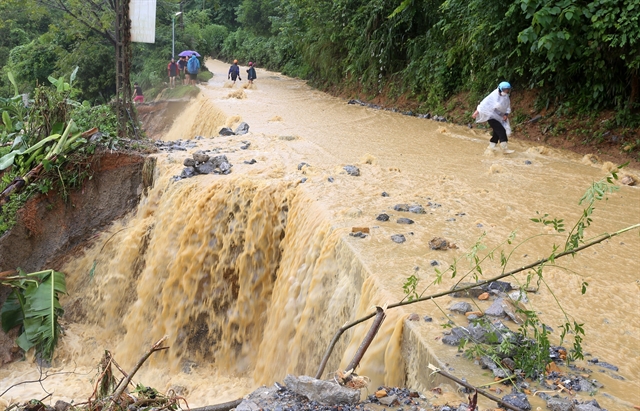 Society
Society

 |
| The main road leading to a remote commune in Bảo Thắng District, northern border province of Lào Cai, was severly damaged following downpour and riverine floods in September last year. — VNA/VNS Photo Quốc Khánh |
HÀ NỘI — Việt Nam and Yemen share 15th position in the list of countries at the most risks of natural disasters globally in 2023, an improvement from the 12th position in 2022 for the country, according to the latest WorldRiskReport.
The dimensions of risks for Việt Nam measured in the report, Exposure and Vulnerability (Susceptibility, Lack of Coping Capacities, and Lack of Adaptive Capacities), are in the 'very high' level in the five-level classification (starting from very low, low, to medium, and to high and very high).
The methodology used in the WorldRiskReport operates on the fundamental principle that the occurrence of a disaster hinges not solely on the intensity of natural hazards impacting a community, but also on the susceptibility of the community to their effects.
Types of natural disasters covered by the report include earthquakes, tsunamis, cyclones, coastal floods, riverine floods, droughts and rises in sea levels.
The report covers all 193 United Nations-recognised countries/territories and more than 99 per cent of the world's population.
The Philippines (WRI 46.86), Indonesia (WRI 43.50), and India (WRI 41.52) are the three top countries at risks.
The composition of the ten countries with the highest risk remains virtually unchanged compared to the previous year. Only Pakistan has dropped out of the group due to Russia moving up to eighth place.
Concerning exposure, the results show similarities: seven countries with the highest risks also rank among the ten countries with the highest exposures. alongside Pakistan, Việt Nam, Papua New Guinea, and Madagascar, which belong to the extended top group in both spheres. However, a very high exposure does not always correlate with very high risks, as South Korea and Italy, or to a lesser extent, Japan and the US, demonstrate. These countries can noticeably reduce their disaster risks through their medium to low vulnerabilities. — VNS




